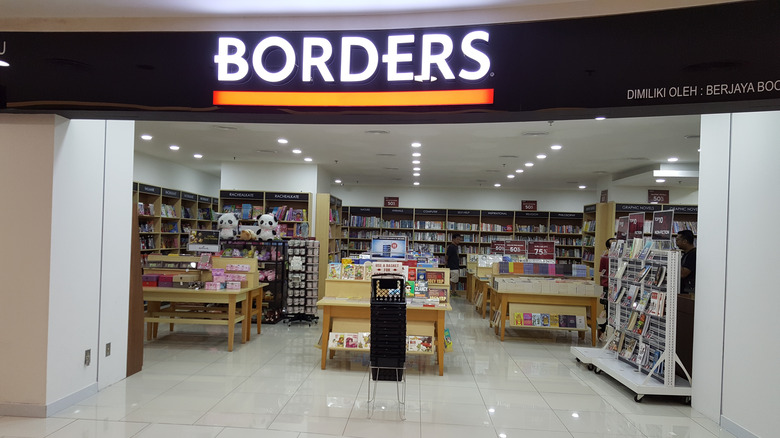What Happened To Borders Bookstores?
You might remember Borders bookstores. They were all over the country in the early 2000s, selling all kinds of books and even multimedia like CDs and movies. Their stores ranged from small outlets in shopping malls to huge buildings packed full of books. In 2003, according to NPR, there were more than 1,200 of the stores nationwide. But by 2012, the chain had liquidated and closed all of its locations.
Bookstores like Barnes & Noble still hold ground in the bookselling market, and the oldest bookstore in America is still standing after more than 150 years. Clearly, people are still reading, and they're going to bookstores to discover new favorites. Borders, a familiar sight and staple storefront for more than four decades, faced plenty of problems in its final years. But what was the final straw for the bookselling giant? Was it a shift to online sales and e-readers, or something else?
The store didn't have great online sale strategies
When Borders first entered the scene, there wasn't really an online marketplace. It made its name by being a big box store where everyone could find something they wanted, according to NPR. But when the internet came around, customers found other ways to get their reading fix.
Other retailers created websites to help move products along. But Borders opted to go a different route. The store actually opted to use Amazon to sell its online products, according to Time, instead of creating its own online marketplace. Time reports that the decision meant Borders handed over control over its online presence and that the lack of cohesive branding likely hurt the store in the long run.
Borders did have its own website for a while. Surprisingly, it was actually hurting the company, and according to Lit Reactor, that website cost the company $20 million to maintain even before it started working with Amazon. That's not exactly a recipe for success.
E-readers and digital books were more popular
The creation of the internet marketplace led to another trend that hurt Borders' prospects. On top of buying physical books online, readers started to shift to electronic books (via Time). Over the early 2000s, e-books outpaced the sale of physical books, according to Time.
Other outlets saw the change coming and adapted. Barnes & Noble created its Nook e-reader to compete with Amazon's marketplace, according to Time, but Borders never created its own e-reader. In an online essay about the bookstore's closure, former Borders Director of Merchandise Planning and Analysis Mark Evans in part blamed the slow adaptation to e-books.
"[Borders] also dropped the ball on e-books," Evans wrote. "But by the time this became an issue they were just trying to figure out how to keep the whole house from burning down around them, so I find it more understandable."
Without a place to direct people interested in e-books, Borders missed out on a market that could have brought in more sales.
It invested too much in selling other media
Borders might have started out as just a bookstore, but it didn't stay that way. The stores later shifted to selling DVDs and CDs and opted to heavily focus on that market in the 1990s, according to Time. But ultimately, it wasn't as great a success as business executives might have hoped for. The iPod and other MP3 players came through shortly after the shift, and it drew customers away from the physical media Borders was selling (via Time).
According to Lit Reactor, Borders filled almost half of its retail space with CDs. That left them with a lot of empty or underutilized space later on when CDs fell out of fashion, including warehouse space. According to Evans, it took a lot of resources to fill the empty space and the loss of revenue that came around when CDs fell out of fashion.
Their troubles with real estate strategy
Another issue that pops up during a Borders post-mortem is somewhat easier to understand. The hypothesis is that Borders went on a commercial retail buying spree and bought up too many storefronts — and simply didn't have enough money to support them. According to Time, a vast majority of its stores were also in close proximity to other booksellers like Barnes & Noble. So on top of the shift to online sales and e-books, there were too many physical bookstores (both other stores in the chain and competitors) around wherever a Borders was operating.
According to NPR, Borders bought up plenty of real estate in the 1990s when the business was doing well. It might have been that they couldn't sustain that level of expense, and eventually it caught up with them. That theory is backed up by former employee Mark Evans, too according to NPR. He says they didn't do as well with relocating stores to better locations, and their storefronts couldn't compete with other stores in the area. The company was also trying to recover from massive debt, according to Time, even before the market crash in 2008.
The workplace atmosphere might have played a part
The issues with online sales and real estate were all pretty visible from the outside. But there's also some commentary on the differences in workplace atmosphere between Borders and other retailers. Barnes & Noble, for example, gave its employees an opportunity to try other things. According to Lit Reactor, some were able to work as baristas or fill other roles in addition to cashier or bookseller duty. And a different seller, Half Price Books, also offered better policies for workers, including paid hour-long lunches, full benefits, and better wages. Those factors probably didn't lead directly to Borders' closure, but they didn't help them, either.
Borders closed its doors for a variety of reasons. Some of those were due to management, while others were the result of a changing market. But the bookselling industry is still going strong. From at least some analyses, Borders' disappearance even allowed independent booksellers to expand and flourish in different parts of the country. But for many, the loss of the traditional big-box storefronts is still a sore subject.





